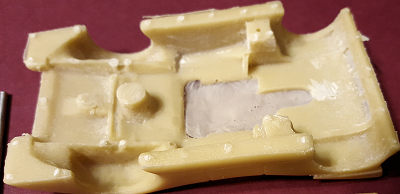
| KIT #: | 125 |
| PRICE: | $45.00 SRP |
| DECALS: | Two options |
| REVIEWER: | Scott Van Aken |
| NOTES: | Resin and cast metal |

| HISTORY |
The BRM P 154 was designed and built in house by British Racin Motors to compete in the 1970 Can-Am series for Group 7 cars by Tony Southgate, who had joined BRM in 1969. Southgate had worked earlier at Lola working on the T70.
While he worked on the Formula 1 BRM P153 car he was tasked to design a CAN-Am car as part of the project 154. For the new BRM Can-Am car, Southgate developed a very conventional aluminum monocoque chassis with independent suspension on all four corners. While BRM, like Ferrari, usually produced all major components in-house, the specific needs of Can-Am racing prompted the manufacturer to use a third-party drivetrain. This consisted of a big-block Chevrolet V8 engine and a Hewland four-speed gearbox though an engine shop was set up to further develop the engine.
Known as the P154, the new BRM was clothed in a lightweight fiberglass body. Tony Southgate believed sufficient downforce could be created by a wedge-shaped body, so no separate rear wing was fitted. Instead the rear body-work boasted a 'ducktail' that was 83in. wide. They had intended the body to cover a pair of special wide rear Firestone tires that never appeared. The broad nose featured a low-mounted radiator intake with the hot air exiting ahead of the cockpit. The P154 was finished in white with red and green stripes courtesy of sponsor Castrol. Testing of the new car was minimal and it was sent off to America with mechanics Roger Bailey who formerly worked with Chris Amon and his Can-Am effort and Mike Underwood to sort out.Tasked to drive the BRM P154 was the team's Canadian driver George Eaton, who had previously raced in the Can-Am with private entries. The car was ready for the opening round at Mosport where Eaton qualified seventh but failed to finish with mechanical issues. This revealed a weakness in BRM's operation caused mainly by the lack of experience with running and more importantly properly tuning the big American engine. All this was briefly forgotten a fortnight later when Eaton placed third at Mont-Tremblant. This success was short-lived as Eaton would not finish another race that season due a myriad of problems. For the final three races, he was joined by BRM's #1 driver Mexican Pedro Rodriguez; the team's principal F1 driver. He actually faired little better, finishing ninth at Donnybrooke, fifth at Laguna Seca and third at Riverside.
| THE KIT |
 A
considerable number of years back, I built M.A. Models' Ford Honker II Can-Am
racer and swore I'd never build another from these folks. Well, time has a way
of changing things, one of which is my ability to w
A
considerable number of years back, I built M.A. Models' Ford Honker II Can-Am
racer and swore I'd never build another from these folks. Well, time has a way
of changing things, one of which is my ability to w ork
on these sorts of kits. The molding on this one is better than before in that
there are no surface air bubbles, but the rest of the molding can be charitably
called average.
ork
on these sorts of kits. The molding on this one is better than before in that
there are no surface air bubbles, but the rest of the molding can be charitably
called average.
The resin has the usual flash and a ton of small stubs on the underside of the resin parts to remove. Fortunately, I have 80 grit paper to deal with these. There are also a few clear blobs that I can only assume are some sort of incomplete molding. These will also need to be attended to. Some of the more fragile parts are on sections of 3x5 card. The tires are rubber. Red plastic tail lights are provided as well as a steel front axles. The rear wheels fit on the stubs of the rear axle assembly you see just above the two headers. A vacuformed windscreen is provided that will need to be tinted a clear green. The majority of the small parts are indifferently cast metal items with considerable mold seams. However, some quality time with files will take care of those.
Instructions are basically an exploded view that has been somewhat crudely hand drawn, but is adequate to complete the kit. Two photos of a completed model are provided for reference. The car is basically white with the decals in green and red attached. Also as a decal is a seat harness. The kit came with two sets of decals, and that isprobably due to the one pair of 8s being in the wrong font. There are markings for both the #98 and #1 cars
| CONCLUSIONS |
Those who are used to Marsh Models or even Provence Moulage or Starter kits will be taken aback at these kits. However, they are not unbuildable and provide an excellent source of many Can-Am racers. Probably the best part of the deal is that they are half the price, the tradeoff being they will take more work.
| REFERENCES |
http://www.grandprixhistory.org/brmp154.htm
April 2018
Copyright ModelingMadness.com. All rights reserved.
If you would like your product reviewed fairly and fairly quickly, please contact the editor or see other details in the Note to Contributors.
Back to the Main Page Back to the Review Index Page Back to the Previews Index Page